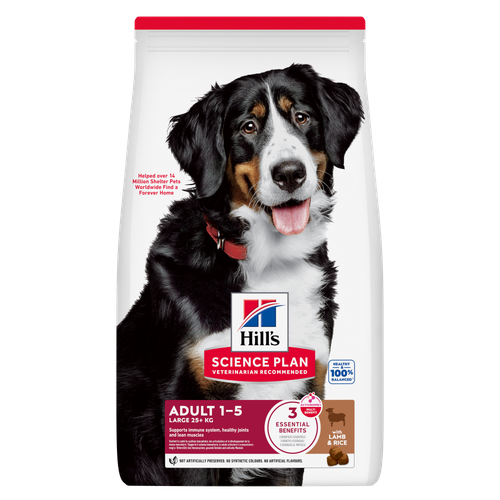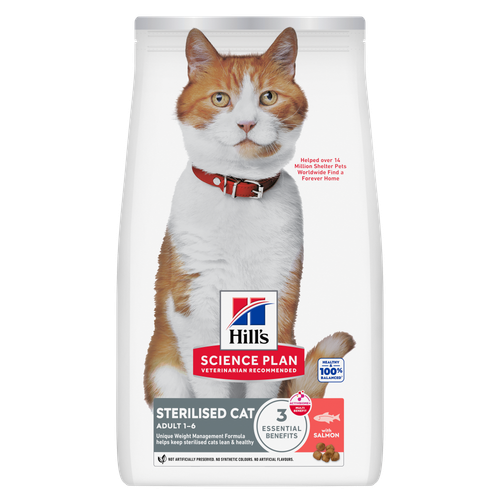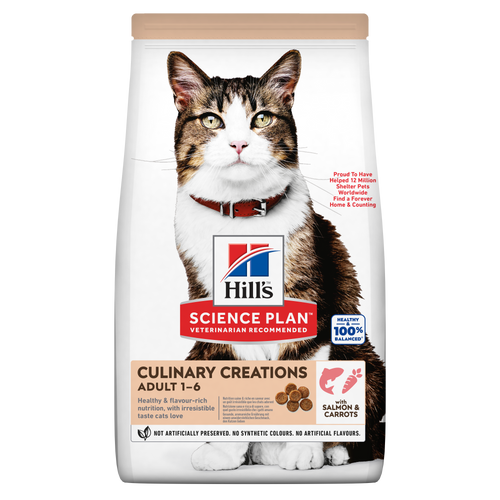
-
Find the right food for your petTake this quiz to see which food may be the best for your furry friend.Find the right food for your petTake this quiz to see which food may be the best for your furry friend.Featured products
 Large Breed Adult Dog Food
Large Breed Adult Dog FoodHill's Science Plan Large Breed Adult Dog Food with Lamb & Rice is a complete pet food, specially formulated with ActivBiome+ Multi-Benefit Technology.
This food is specifically designed to fuel the energy needs of large breed dogs during the prime of their life.Shop Now Adult Light Dog Food
Adult Light Dog FoodHill's Science Plan Light Adult Wet Dog Food is a complete premium pet food for adult dogs that tend to gain weight easily. This deliciously smooth loaf is formulated to deliver the appropriate amount of energy to support weight maintenance in adult dogs.
Shop Now Perfect Digestion Large Breed Puppy Food
Perfect Digestion Large Breed Puppy FoodPrecisely balanced nutrition with Hill's ActivBiome+ prebiotic blend actively contributes to supporting digestive health and overall wellbeing to help your pet feel their best
Shop NowFeatured products Sterilised Adult Cat Food
Sterilised Adult Cat FoodHill's Science Plan Adult Sterilised Cat Dry Food with Salmon is specially formulated with ActivBiome+ Multi-Benefit Technology. It is a precisely balanced nutrition, tailored to meet the needs of sterilised cats, to help keep sthem lean & healthy.
Shop Now CULINARY CREATIONS ADULT CAT FOOD
CULINARY CREATIONS ADULT CAT FOODHill's Science Plan CULINARY CREATIONS Adult cat food with Salmon & Carrots was formulated to provide a great-tasting experience to cats. Its delicious flavour and texture are combine with essential nutrients to support cats' optimal health during the prime time of their life. Specially formulated with high-quality salmon protein, essential taurine for heart health & balanced minerals to support kidneys & bladder.
Shop Now Adult Cat Food
Adult Cat FoodHill's Science Plan Adult Cat Food with Chicken is a complete pet food, specially formulated with ActivBiome+ Multi-Benefit Technology.
This food is specially formulated to fuel the energy needs of cats during the prime of their life.Shop Now -
Dog
- Dog Tips & Articles
-
Health Category
- Weight
- Food & Environmental Sensitivities
- Urinary
- Digestive
- Joint
- Kidney
-
Life Stage
- Puppy Nutrition
- Adult Nutrition
- Senior Nutrition
Cat- Cat Tips & Articles
-
Health Category
- Weight
- Skin & Food Sensitivities
- Urinary
- Digestive
- Kidney
-
Life Stage
- Kitten Nutrition
- Adult Nutrition
Featured articles Pet Nutrition: What Makes "Healthy" Pet Food Healthy? | Hill's Pet
Pet Nutrition: What Makes "Healthy" Pet Food Healthy? | Hill's PetIn people, the right diet is very important. If you are eating the wrong way for your metabolism, activity level, age and lifestyle you could end up with health issues.
Read More The Incredible Science Behind Your Pet's Microbiome
The Incredible Science Behind Your Pet's MicrobiomeLearn what your pet's microbiome is, how it contributes to your pet's gut and overall health, and why nutrition is important in maintaining healthy microbiomes.
Read More Microchipping: The Facts | Hill's Pet
Microchipping: The Facts | Hill's PetThe government has announced that as of April 2016, all dogs in the UK must be microchipped by law.
Read More -


If you have a dog or are seriously thinking of bringing a new dog into your home, you’ve likely heard a lot of expert dog training advice, either from books, magazines or television programmes. Expert dog trainers agree that dog treats are an effective and appropriate training tool and a great way to say “well done” in terms your dog clearly understands.
But did you know that treats are also important to bonding with your canine friend? Dogs are a social species, just like humans. Both four-legged and two-legged friends can benefit from the social aspect of treats – a display of love and affection from one individual to another through the sharing of (yummy) resources.
When and where to give treats
Be sure to think outside of your usual routines when sharing treats with your dog. Bonding can happen at any time, and your dog should learn that any moment spent with you is a positive one. Surprise him with a delicious treat while you’re both snuggled up on the couch or when you come home from work! Make these kinds of treats a randomly timed surprise, and be sure not to encourage cheeky treat-seeking behaviours or give potentially harmful human foods.
During training sessions, give treats promptly when he’s done something well, whether you are at home, in the dog park or out on the town. In this case, you will be rewarding proper dog behaviour within any given environment, which should be the goal. Aromatic treats are best for training. The appealing scent will be positively associated with the new skill, helping to build on the training results.
If you want to condition your dog to like a new location, such as the vet’s surgery or your new home, giving treats and lots of praise and attention in those places can help him feel at ease.
Carefully consider the circumstances before you give a treat, and stay on guard for potential training traps. For example, giving treats to your dog while you are sitting at the table may simply teach him to pester you every time you sit down for a meal. This will require paying close attention at first, but it will soon become second nature.
Give treats only when your dog is calm and acting in a way you want. If he is jumping up or barking to demand a treat, you can end up rewarding his naughty ways by giving in.


Tasty Tips
Not all treats are created equal
Giving human foods or low-quality pet treats can give your pet a tummy full of unhealthy fats, sugars, flavourings, or excess salt, all of which can easily cause digestive upset or worse. Some human foods are even poisonous or toxic for dogs, especially chocolate or anything containing onions, raisins, or caffeine.
Too many treats, or inappropriate treats, can significantly impact a dog’s weight and overall health. Canine obesity is a serious health issue that’s best avoided entirely. Obesity can even shorten your dog’s lifespan and lower his quality of life! Be sure your dog is getting healthy treats that won’t cause him to gain weight or compromise the weight loss goals you’ve already set for him.
Here’s a little human comparison chart to show in human terms just how unhealthy some commonly-fed dog “treats” can be:
| 15kg dog (854 kcal/day) | Average adult (165cm tall, 2000kcal/day) | |
|---|---|---|
| 28gr cheese | = | 1 hamburger |
| 1 cookie | = | 2 scoops of ice cream |
| 2 slices of salami | = | 4 cookies |
| 1 dental stick | = | 1 chocolate bar |
The best treats for your dog are super-tasty titbits that he'll love to nosh and which will support his overall health by avoiding excess calories. Seek out natural ingredients whenever possible and check labels carefully before you buy. Remember – not all treats are created equal, and some can even offer health benefits beyond simply a tasty snack.
Choose your treats – as well as the time and location of giving them – wisely, and you’ll help reinforce a deeper bond along with better behaviour and better lifelong health in your beloved dog. A treat indeed.


One of our staff authors prepared this article for you
Related products

Hill's Science Plan Adult Wet Dog Food with Turkey is a complete premium pet food for adult dogs from 1 year. This deliciously smooth minced turkey loaf is formulated to deliver the appropriate amount of energy to support the needs of adult dogs.

Precisely balanced nutrition with Hill's ActivBiome+ prebiotic blend actively contributes to supporting digestive health and overall wellbeing to help your pet feel their best

Hill's Science Plan Light Adult Wet Dog Food is a complete premium pet food for adult dogs that tend to gain weight easily. This deliciously smooth loaf is formulated to deliver the appropriate amount of energy to support weight maintenance in adult dogs.

Hill's Science Plan Large Breed Adult Dog Food with Lamb & Rice is a complete pet food, specially formulated with ActivBiome+ Multi-Benefit Technology.
This food is specifically designed to fuel the energy needs of large breed dogs during the prime of their life.
Related articles
Discover the causes, signs, and treatments of kidney disease in dogs and find methods of supporting your dog's kidney health. Learn more at Hill's Pet.

Gurgling tummies in turmoil are not good news for pets. Owners who have to clean up the unfortunate consequences, digestive problems are one of the rare downsides to owning a pet.

Learn to see the signs of an upset stomach in your dog, understand the triggers and explore some possible solutions.

Dog obesity is a significant problem - learn more about helping your dog become trimmer and healthier through improved nutrition.

Put your dog on a diet without them knowing
Our low calorie formula helps you control your dog's weight. It's packed with high-quality protein for building lean muscles, and made with purposeful ingredients for a flavourful, nutritious meal. Clinically proven antioxidants, Vitamin C+E, help promote a healthy immune system.
Put your dog on a diet without them knowing
Our low calorie formula helps you control your dog's weight. It's packed with high-quality protein for building lean muscles, and made with purposeful ingredients for a flavourful, nutritious meal. Clinically proven antioxidants, Vitamin C+E, help promote a healthy immune system.

